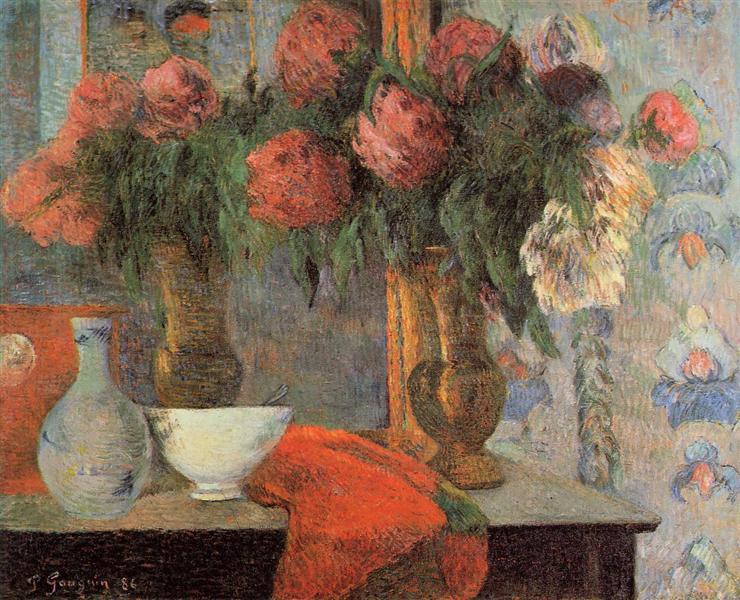Description
Paul Gauguin's Still Life with White Bowl (1886) is a significant piece that reflects the development of his personal and innovative style in the context of Post-Impressionism. Dating from a time when Gauguin was beginning to move away from the naturalism of Impressionism towards a more symbolic and bold interpretation of colour and form, this painting offers us a captivating insight into his artistic evolution.
The composition focuses on a white bowl, an element that acts not only as a central object in the work, but also as a symbol of simplicity and elegance. Surrounded by fruit and flowers, the bowl seems to radiate a luminosity that subtly contrasts with the darker, earthier colors of the background. The fruits, in their warm shades of red and yellow, create a powerful visual dialogue with the coldness of the white container, emphasizing the duality between the everyday and the exceptional. This balance between vibrant colors and more muted tones is a distinctive feature of Gauguin’s work, which strives to go beyond a simple representation of nature; he seeks an emotional and almost spiritual expression through his palette.
The way Gauguin applies color plays a crucial role in the work. His use of color is not merely descriptive; each hue seems charged with meaning. This approach highlights the influence of his interest in symbolism and the search for something deeper in the visual. In "Still Life with White Bowl," color becomes a vehicle for conveying sensations and moods, suggesting that a still life may, in fact, be alive with meaning and emotion.
It is also interesting to observe the arrangement of the elements within the composition. The asymmetrical arrangement of the bowl, along with the placement of the fruit and flowers, elicits a sense of dynamism. Unlike so many classical still lifes that tend toward orderly, predictable symmetry, Gauguin's work feels as if it pulses with life and movement, inviting the viewer to look beyond the surface.
The work was created during a period when Gauguin was influenced by a mixture of styles, including Impressionism, but also the traditions of the indigenous cultures he was interested in. While Still Life with White Bowl does not include human figures, the influence of more primitive artistic representations and the search for deeper meaning in the relationship between color and form are evident. This approach is seen in his later evolution in places such as Tahiti, where Gauguin would explore these themes further.
Contemporary paintings by Gauguin, as well as other Post-Impressionists, often display this search for a more intense emotional connection through paint. As the work is presented within this context, we can begin to appreciate not only the aesthetic significance of "Still Life with White Bowl," but also its place in the broader dialogue about innovation in art in the late 19th century.
Gauguin's White Bowl is not just an object on the table, but a testament to his mastery and artistic vision. Through this work, Gauguin continues to transcend mere visual taste, aiming for a visceral connection between the viewer and the work, a trait that has ensured its relevance in art history to this day. The painting thus becomes an exploration not only of still life, but of life itself and the meaning that objects can contain within it.
KUADROS ©, a famous painting on your wall.
Hand-made oil painting reproductions, with the quality of professional artists and the distinctive seal of KUADROS ©.
Painting reproduction service with satisfaction guarantee. If you are not completely satisfied with the replica of your painting, we will refund 100% of your money.

